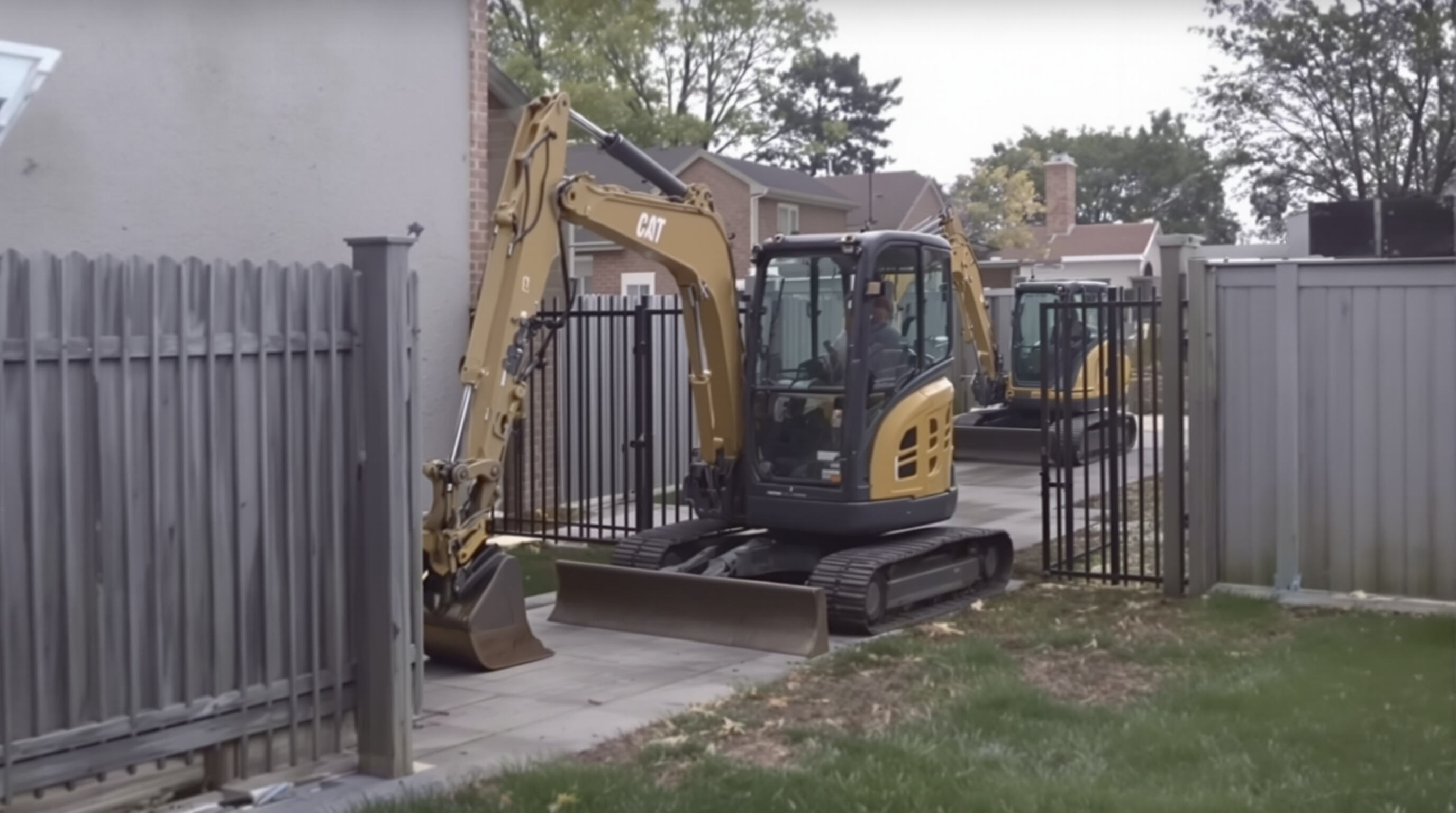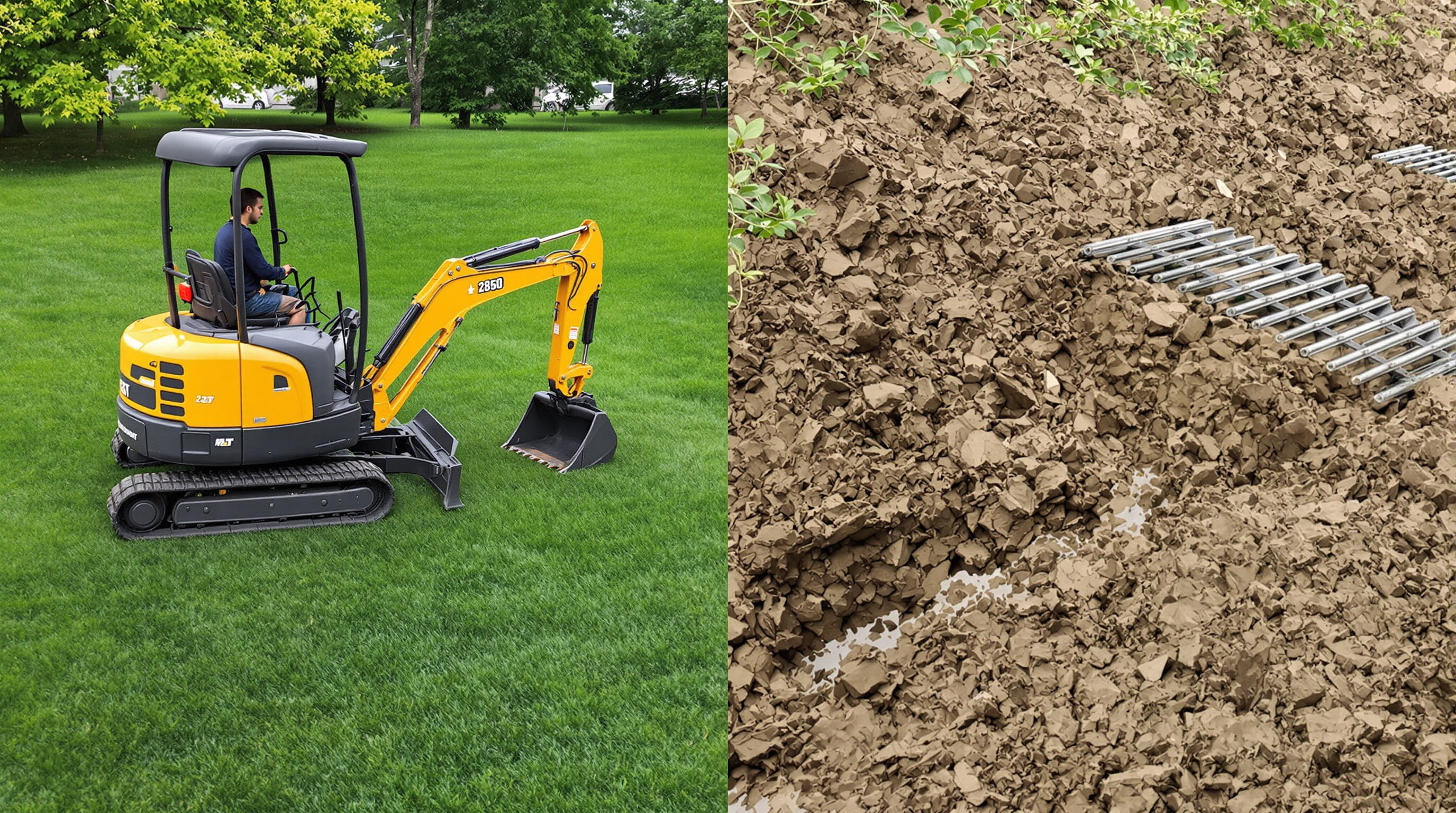كيفية اختيار الحفارة الصغيرة المناسبة للاستخدام المنزلي؟
فهم الحجم والوزن والمناورة المناسبة للوصول إلى المناطق السكنية

فئات الحجم والوزن: مطابقة أبعاد الحفارة الصغيرة للقيود الموجودة في الفناء الخلفي
عند اختيار حفار صغير لمالك المنزل، تؤثر الوزن والأبعاد بشكل مباشر على القابلية للاستخدام في المساحات السكنية. عادةً ما يقل عرض النماذج المدمجة (1–3 طن) عن 7 أقدام وارتفاعها عن 8 أقدام، مما يسمح بالوصول عبر البوابات القياسية والمسارات الضيقة. تشمل الاختلافات الرئيسية بين النماذج المدمجة والنماذج القياسية ما يلي:
| مميز | النماذج المدمجة | النماذج القياسية |
|---|---|---|
| متوسط الوزن أثناء التشغيل | 1800–3200 رطلاً | 4500–7500 رطلاً |
| عرض النقل | <36 بوصة | 48–60 بوصة |
| أعمق حفر | 8–10 أقدام | 12–14 قدمًا |
| المشاريع المثالية | البلاطات، الصرف الصحي | المداخل، الأساسات |
أظهر استبيان لبناء المساكن لعام 2023 أن 68% من أصحاب المنازل الذين يستخدمون معدات تزيد عن 4000 رطلاً احتاجوا إلى تعديلات في الممتلكات لمنع تلف العشب أو الإجهاد الهيكلي.
الدوران الصفري للذيل مقابل الدوران التقليدي: التنقل بين الأسوار والجدران وخطوط الملكية الضيقة
يمكن للحفارات الصغيرة ذات الدوران الخلفي الصفري تقليل المساحة المطلوبة بنسبة تقارب 30٪ مقارنةً بالطرازات العادية، نظرًا لعدم وجود زوائد مزعجة من الخلف عند الدوران. ما المقصود عمليًا بذلك؟ يمكن لهذه الآلات العمل بكفاءة في مناطق بعرض 10 أقدام فقط، وهو أمر بالغ الأهمية في المهام القريبة من الأسوار أو خطوط المرافق المزعجة التي تمتد عبر الممتلكات. وفقًا لملاحظات عديدة من مراكز تدريب المعدات المنتشرة في جميع أنحاء البلاد، يلاحظ المشغلون الذين ينتقلون إلى هذه الآلات ذات الذيل الصفري حدوث عدد أقل بكثير من الحوادث التي تتسبب في تلف الجدران. وأفاد أحد المراكز بانخفاض بلغ نحو 85-90٪ في مثل هذه الحوادث تحديدًا في الأفنية الخلفية الحضرية الضيقة حيث تكون المساحة شحيحة.
النماذج السكنية مقابل التجارية: لماذا يهم التصغير في الاستخدام المنزلي
تتميز الماكينات الصغيرة الحفارة التجارية بقوة هيدروليكية كبيرة وبنيان متين يدوم طويلاً، بينما تلك المخصصة للاستخدام المنزلي تركز على القدرة على الوصول إلى الأماكن الضيقة وسهولة التشغيل. تأتي الإصدارات السكنية بمواصفات مثل دعامات تثبيت أقصر تزيل أقل من 12 بوصة من التربة، واهتزازات لا تتجاوز 3.5 متر في الثانية المربعة أثناء التشغيل العادي، وأزرار تحكم سهلة الاستخدام ولا تحتاج إلى معرفة هندسية لتشغيلها. كما أنها تناسب داخل الجراجات، وهو أمر مهم للغاية، حيث يفضل حوالي 8 من كل 10 مالك منزل امتلاك جهاز يناسب مساحة الجراج الخاصة بهم بدلًا من التركيز على أقصى قوة رفع ممكنة.
تقييم عمق الحفر، والوصول، ومرونة الذراع لمشاريع المنازل النموذجية
العمق الأساسي المطلوب في الأعمال المنزلية: الأساسات، والصرف، وخنادق الخدمات العامة
لغالبية مشاريع المنازل التي تُعنى بتصليح مشاكل الصرف التي تمتد بعمق حوالي 12 إلى 18 بوصة، أو تركيب خطوط الخدمات التي تحتاج عمومًا إلى حفر يتراوح بين 24 إلى 36 بوصة، يجد أصحاب المنازل أن المعدات القادرة على الوصول إلى عمق يتراوح بين 5 إلى 7 أقدام تحت الأرض تؤدي المهمة بشكل كافٍ. تُظهر نظرة حديثة على بيانات المعدات السكنية أن هذه الأعماق تغطي فعليًا حوالي 90 بالمائة من متطلبات المشاريع المنزلية المتوسطة. هناك بالفعل نماذج متوفرة الآن تمتد لحوالي 7.4 أقدام، لذا فهي تعمل بشكل جيد إلى حد كبير في المشاريع الأكبر مثل إعداد القاعدة لبركة سباحة داخل الأرض دون الحاجة إلى استئجار معدات تجارية باهظة الثمن من مكان ما.
تحسين مدى الامتداد الأفقي ونصف قطر الدوران في الأفنية الخلفية المغلقة
في تصميمات الفناء الخلفي الضيقة، يكون الامتداد الدقيق أمرًا ضروريًا:
- يمكن الامتداد الأفقي من 8 إلى 11.5 قدم وضع الحاوية حول العوائق دون الحاجة إلى إعادة التموضع
- تتيح نصف أقطار الدوران الأقل من 40 بوصة الدوران الكامل بين الأسوار أو أحواض الزراعة
- تقلل تصميمات الذراع القصيرة من النقاط العمياء بنسبة 27% مقارنة بالنموذج ذات الذراع الممتدة (مجلة البناء الميكانيكي 2023)
تُضمن هذه المقاييس الكفاءة في العمل داخل القطع السكنية ذات المساحة المحدودة
وظيفة دوران الذراع: العمل بأمان بالقرب من المباني دون الحاجة إلى إعادة وضع الماكينة
تتيح الذراع المتصلة بزاوية دوران تتراوح بين 140° و 175° الحفر المُنحرِف، ما يسمح للمالكين بحفر الأساسات على بعد 18 بوصة من أساسات المنزل مع إبقاء الكابينة على مسافة 4–6 أقدام. تقلل هذه الميزة من خطر إلحاق الضرر بالممتلكات بنسبة 68% مقارنةً بالعمل باستخدام الذراع الثابت، وفقًا لدراسة ميدانية استمرت 12 شهرًا في مشاريع تنسيق الحدائق السكنية
التوازن بين قوة المحرك والأداء الهيدروليكي والمتانة للاستخدام المنزلي
قوة المحرك وكفاءة استهلاك الوقود: تجنب النماذج ذات الطاقة المنخفضة أو المعقدة بشكل مفرط
لمعظم مشاريع الصيانة المنزلية، تعمل الحفارات الصغيرة ذات القدرة بين 14 إلى 25 حصانًا بشكل مناسب عند حفر الخنادق أو إعداد القواعد. وبحسب بحث حديث نشره موقع Equipment World في عام 2023، فإن الآلات ضمن هذا النطاق من القدرة تنهي المشاريع الشائعة أسرع بنسبة 35 بالمئة تقريبًا مقارنة بالطرازات الأصغر. كما أنها توفر ما يقارب 15 إلى 20 بالمئة في تكاليف الوقود مقارنة بالآلات الأكبر التي تستهلك كميات أكبر. على أصحاب المنازل تجنب محركات الفئة التجارية التي تحتاج إلى سائل DEF أو أنظمة معقدة للتحكم في الانبعاثات. تتسبب هذه المزايا المتقدمة في تعقيدات إضافية وتتطلب صيانة إضافية لا يريدها أحد عند استخدام المعدات بشكل غير منتظم.
جودة النظام الهيدروليكي: التبريد، حماية الخطوط، والخيارات الهيدروليكية الإضافية
تُظهر النماذج المزودة بمضخات هيدروليكية ذات تحكم حراري أداءً أفضل عندما ترتفع درجات الحرارة خلال أشهر الصيف. كما تُحدث الجوانب المعززة وتلك الأغطية الوقائية الإضافية فرقاً كبيراً أيضاً، حيث تمنع التسرب الذي يحدث غالباً عندما تعلق المعدات في التضاريس الصخرية. لقد واجهنا هذا المشكل كثيراً بأنفسنا. وبالحديث عن القابلية للتكيف، فإن وجود هيدروليك مساعد مدمج مباشرةً في النظام يعني أن المشغلين يمكنهم تشغيل الملحقات مثل المثاقب أو المكابس مباشرةً من الآلة بدل الاعتماد على تلك الإضافات الخارجية المكلفة التي تستغرق وقتاً طويلاً جداً لتُثبت بشكل صحيح.
تصميم يضمن المتانة للاستخدام المنزلي المتقطع والتخزين الموسمي
تم تصميم الحفارات الصغيرة المخصصة لمالكي المنازل بحيث يمكنها التحمل جيدًا أثناء فترات الخمول لفترات طويلة. يعرف المصنعون أن التآكل الناتج عن التخزين هو ما يؤدي عادةً إلى تلف هذه الآلات، ولهذا يضيفون ميزات مثل قضبان أسطوانات مقاومة للصدأ ووصلات كهربائية محكمة ضد الماء. وبحسب دراسة حديثة نُشرت في 2024 حول متانة المعدات الاستهلاكية، فإن الاهتمام بهذه التفاصيل يُحدث فرقًا كبيرًا. هل ترغب في أن تكون آليتك جاهزة عند الحاجة؟ جرب تشغيلها مرة واحدة كل شهر للحفاظ على حركة السوائل داخلها. احفظها تحت مظلة تسمح بمرور الهواء وتحجب الأمطار، وليس مجرد غطاء قديم. كما تحقق بانتظام من نقاط التزييت دون الحاجة إلى تفكيك الأجزاء بالكامل. إن اتباع هذه الخطوات البسيطة يعني تجنب الكثير من المتاعب في فصل الربيع، عندما يحتاج الناس إلى إصلاح حدائقهم أو مواجهة حالات إصلاح طارئة غير متوقعة.
الاختيار بين السلاسل المطاطية والصلب حسب نوع التضاريس وحماية السطح

السلاسل المطاطية: تحافظ على المروج والمداخل والطرق الممهدة في المناطق السكنية
تُوزِّع المسارات المطاطية الوزن بشكل أفضل مقارنةً بالمسارات الفولاذية، مما يقلل الضغط على الأرض بنسبة تقارب 30%. ما النتيجة؟ تقليل الضرر الذي يصيب المناطق العشبية والمداخل والجلسات الخارجية التي يقضى وقت طويل في إعدادها. وبحسب بعض الدراسات من القطاع الصناعي، فإن الآلات التي تستخدم مسارات مطاطية تشوه السطح بنسبة تصل إلى ربع ما تُحدثه المسارات الفولاذية في المناطق السكنية. مع ذلك، من المهم ملاحظة أن هذه المكونات المطاطية تحتاج إلى فحص دوري للبحث عن أي علامات تآكل مثل الشقوق أو الثقوب، خاصة إذا كانت تعمل بالقرب من التضاريس الصخرية أو في أماكن مليئة بالحطام.
المسارات الفولاذية: تُحسّن الجر والاستقرار على التضاريس الوعرة أو غير المستوية في الفناء الخلفي
توفر المسارات الفولاذية قبضة أفضل بنسبة تصل إلى 40 بالمائة عند التعامل مع الطين أو الأراضي الوعرة بفضل تلك الزوائد العدوانية التي نراها عليها. تعمل هذه الأنواع من المسارات بشكل استثنائي على المنحدرات الشديدة، والبقع الترابية الناعمة، ومن خلال الغابات الكثيفة حيث تكون القبضة الجيدة أمرًا بالغ الأهمية. فكّر في مهام مثل تسوية التلال أو إنشاء أنظمة تصريف في الأماكن التي لم يتم تطويرها بعد. مع ذلك، الجانب السلبي هو أن المسارات الفولاذية تمارس ضغطًا أكبر بكثير على الأسطح مقارنة بالبدائل المطاطية، حوالي 18 إلى 22 رطلاً لكل بوصعة مربعة إضافية، مما قد يؤدي إلى تآكل أكثر على أي سطح تمر عليه. ولذلك، من المنطقي استخدام المسارات الفولاذية في المناظر الطبيعية غير المطروقة بدلًا من الطرق الممهدة أو النظم البيئية الحساسة.
تفضيل راحة المشغل، السلامة، وتنوع الإكسسوارات للعملاء من أصحاب المنازل
عناصر تحكم سهلة الاستخدام: الأنظمة الهيدروليكية مقابل الميكانيكية وسهولة التعلم للمستخدمين غير المحترفين
توفر أنظمة الذراع الميكانيكية تشغيلًا بسيطًا ومناسبًا للمستخدمين العرضيين، في حين توفر أنظمة الهيدروليك ذات التشغيل التجريبي تحكمًا أكثر سلاسة ولكن مع منحنى تعليمي أكثر حدة. وقد أظهرت دراسة أجرائية لعام 2024 أن 62% من المشغلين الجدد تمكنوا من إتقان التحكم الميكانيكي بسرعة أكبر بنسبة 30%، مما يجعلها مناسبة للمالكين الذين يقومون بمشاريع نهاية الأسبوع.
راحت المشغل: قابلية تعديل المقعد، الرؤية، تقليل الضوضاء والاهتزازات
عندما يشعر المشغلون بالراحة، فإنهم يميلون إلى العمل بشكل أكثر أمانًا وإنجاز مهام أكثر خلال وردياتهم. تلعب مقاعد التعليق التي تحتوي على دعم جيد للظهر منخفض أسفل الظهر فرقًا كبيرًا، خاصة عندما تُدمج مع رؤية بزاوية 180 درجة بالكامل تساعد في التحرك عبر المناطق الضيقة. لقد قللت الآلات الأحدث ذات التصميم المدمج من مستويات الضجيج داخل المقصورة إلى حوالي 78 ديسيبل، وهو ما يُعد في الواقع أقل ضجيجًا من العديد من أدوات الحدائق الشائعة وفقًا للدراسات الحديثة. كما تحتوي هذه الآلات على أنظمة خاصة تمتص الاهتزازات، مما يقلل من التعب بنسبة تصل إلى 40 بالمائة تقريبًا كما ورد في تقرير الآلات الهادئة للعام الماضي. تساعد أشياء مثل مواضع الأذرع القابلة للتعديل ومقصورات المشغلين ذات التحكم في درجة الحرارة في الحفاظ على قوة العمال حتى بعد ساعات طويلة من العمل.
الميزات الأساسية للسلامة: هياكل حماية من الانقلاب (ROPS)، أنظمة الإنذار، والتشغيل الصديق للبيئة المحيطة
من حيث السلامة على المعدات الصغيرة، فإن هياكل الحماية من الانقلاب مزودة بقفل أحزمة الأمان تحدث فرقاً كبيراً. ووفقاً لبيانات إدارة السلامة والصحة المهنية (OSHA) من العام الماضي، فإن هذه الأنظمة تمنع حوالي 89% من الإصابات الخطيرة أثناء الحوادث. أما بالنسبة للأشخاص الذين يستخدمون هذه المعدات بالقرب من المنازل، فهناك بالفعل نماذج مزودة بمستشعرات حركة وإضاءة LED ساطعة تُحذّر الأشخاص القريبين دون إزعاج الجيران كثيراً في الليل. وهنالك شيءٌ مثير للاهتمام: بعض المناطق لديها لوائح تتطلب أن تكون الحفارات الصغيرة التي تقل عن ثلاثة أطنان مزودةً بخصائص إيقاف تلقائي عندما يغادر المشغل المكان بشكل غير صحيح. هذا منطقي جداً، خاصةً في المنازل التي قد يتجول فيها الأطفال أو الحيوانات بالقرب من الآلات.
مُحولات الربط السريع وتنوع الإكسسوارات: المثاقب، الكسارات، المكابس، والكفاءة من حيث التكلفة
تتيح أنظمة الاتصال السريع للمالكين تبديل الإكسسوارات مثل آلات حفر الثقوب في الأعمدة ومكسرات الصخور ومكابس الأشجار في أقل من دقيقتين. هذا يعني أن جهازًا واحدًا يصبح في الأساس كل ما يحتاجه المرء في الممتلكات سواء كان ذلك في إزالة الأشجار أو هدم المباني أو التحرك في الثلوج الشتوية. بالتأكيد، ستكلف الموديلات الهيدروليكية أكثر من الموديلات القياسية بنسبة تتراوح بين 15 إلى 20 بالمئة تقريبًا عند الشراء. ولكن على المدى الطويل، يجد معظم المستخدمين أنهم يوفرون المال لأنهم لا يحتاجون إلى شراء عدة آلات مختلفة لكل مهمة محددة.

